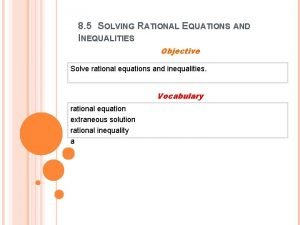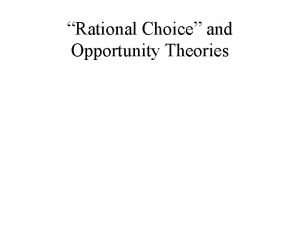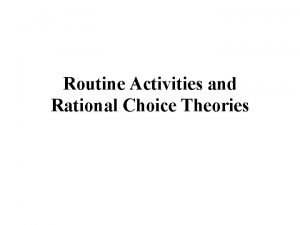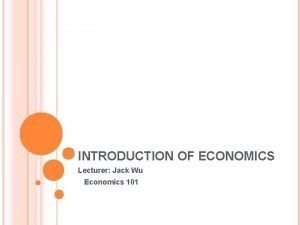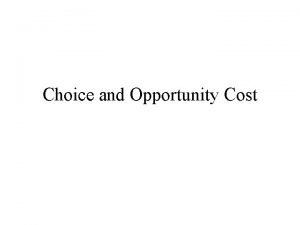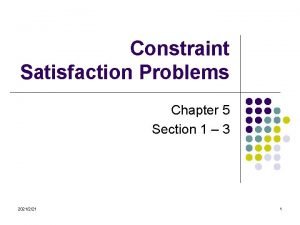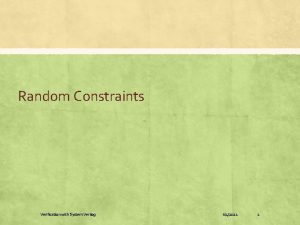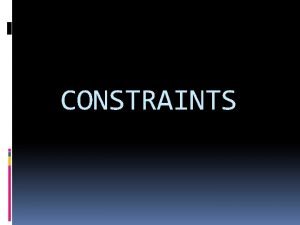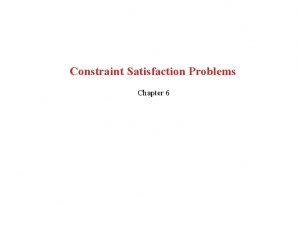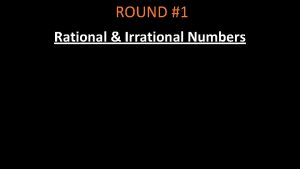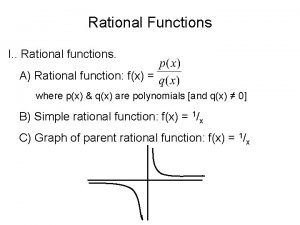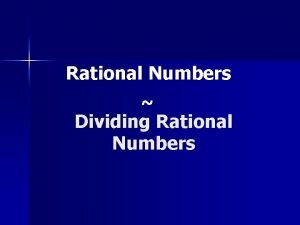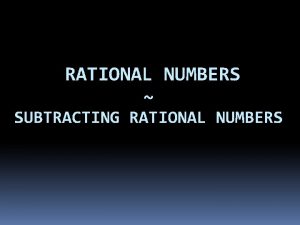Rational Choice CHOICE 1 2 Scarcity income constraint
























































- Slides: 56

Rational Choice

CHOICE 1. 2. Scarcity (income constraint) Tastes (indifference map/utility function)

ECONOMIC RATIONALITY u The principal behavioral postulate is that a decision-maker chooses its most preferred alternative from those available to it. u The available choices constitute the choice set. u How is the most preferred bundle in the choice set located/found?

RATIONAL CONSTRAINED CHOICE x 2 More preferred bundles Affordable bundles x 1

RATIONAL CONSTRAINED CHOICE x 2* x 1

RATIONAL CONSTRAINED CHOICE x 2 (x 1*, x 2*) is the most preferred affordable bundle. x 2* E x 1* x 1

RATIONAL CONSTRAINED CHOICE At Equilibrium E MRS= x 2/ x 1 = p 1/p 2 Slope of the indifference curve Slope of the budget constraint Individual’s willingness to trade Society’s willingness to trade

RATIONAL CONSTRAINED CHOICE u The most preferred affordable bundle is called the consumer’s ORDINARY DEMAND at the given prices and income. u Ordinary demands will be denoted by x 1*(p 1, p 2, m) and x 2*(p 1, p 2, m).

RATIONAL CONSTRAINED CHOICE x 2 The slope of the indifference curve at (x 1*, x 2*) equals the slope of the budget constraint. x 2* x 1

RATIONAL CONSTRAINED CHOICE (x 1*, x 2*) satisfies two conditions: u (i) the budget is exhausted, i. e. p 1 x 1* + p 2 x 2* = m; and u (ii) the slope of the budget constraint, (-) p 1/p 2, and the slope of the indifference curve containing (x 1*, x 2*) are equal at (x 1*, x 2*).

COMPUTING DEMAND u u 1. 2. How can this information be used to locate (x 1*, x 2*) for given p 1, p 2 and m? Two ways to do this Use Lagrange multiplier method Find MRS and substitute into the Budget Constraint

COMPUTING DEMAND Lagrange Multiplier Method Suppose that the consumer has Cobb. Douglas preferences and a budget constraint given by

COMPUTING DEMAND Lagrange Multiplier Method Aim Set up the Lagrangian

COMPUTING DEMAND Lagrange Multiplier Method Differentiate

COMPUTING DEMAND Lagrange Multiplier Method From (1) and (2) Then re-arranging

COMPUTING DEMAND Lagrange Multiplier Method Rearrange Remember

COMPUTING DEMAND Lagrange Multiplier Method Substitute

COMPUTING DEMAND Lagrange Multiplier Method Solve x 1* and x 2* and

COMPUTING DEMAND Method 2 Suppose that the consumer has Cobb-Douglas preferences.

COMPUTING DEMAND Method 2 u Suppose that the consumer has Cobb-Douglas preferences.

COMPUTING DEMAND Method 2 u So the MRS is

COMPUTING DEMAND Method 2 u So u At the MRS is (x 1*, x 2*), MRS = -p 1/p 2 , i. e. the slope of the budget constraint.

COMPUTING DEMAND Method 2 u So the MRS is u At (x 1*, x 2*), MRS = -p 1/p 2 so (A)

COMPUTING DEMAND Method 2 u (x 1*, x 2*) also exhausts the budget so (B)

COMPUTING DEMAND Method 2 u So now we know that (A) (B)

COMPUTING DEMAND Method 2 So now we know that (A) Substitute (B)

COMPUTING DEMAND Method 2 So now we know that (A) Substitute and get This simplifies to …. (B)

COMPUTING DEMAND Method 2

COMPUTING DEMAND Method 2 Substituting for x 1* in then gives

COMPUTING DEMAND Method 2 So we have discovered that the most preferred affordable bundle for a consumer with Cobb-Douglas preferences is

COMPUTING DEMAND Method 2: Cobb-Douglas x 2 x 1

Rational Constrained Choice u But what if x 1* = 0 or x 2* = 0? u If either x 1* = 0 or x 2* = 0 then the ordinary demand (x 1*, x 2*) is at a corner solution to the problem of maximizing utility subject to a budget constraint.

Examples of Corner Solutions: Perfect Substitutes x 2 MRS = -1 x 1

Examples of Corner Solutions: Perfect Substitutes x 2 MRS = -1 Slope = -p 1/p 2 with p 1 > p 2. x 1

Examples of Corner Solutions: Perfect Substitutes x 2 MRS = -1 Slope = -p 1/p 2 with p 1 > p 2. x 1

Examples of Corner Solutions: Perfect Substitutes x 2 MRS = -1 (This is the indifference curve) Slope = -p 1/p 2 with p 1 > p 2. x 1

Examples of Corner Solutions: Perfect Substitutes x 2 MRS = -1 ANOTHER EXAMPLE Slope = -p 1/p 2 with p 1 < p 2. x 1

Examples of Corner Solutions: Perfect Substitutes So when U(x 1, x 2) = x 1 + x 2, the most preferred affordable bundle is (x 1*, x 2*) where if p 1 < p 2 or if p 1 > p 2.

Examples of Corner Solutions: Perfect Substitutes x 2 MRS = -1 Slope = -p 1/p 2 with p 1 = p 2. The budget constraint and the utility curve lie on each other x 1

Examples of Corner Solutions: Perfect Substitutes x 2 All the bundles in the constraint are equally the most preferred affordable when p 1 = p 2. x 1

Examples of ‘Kinky’ Solutions: Perfect Complements X 2 (gin) U(x 1, x 2) = min(ax 1, x 2) x 2 = ax 1 (a =. 5) X 1 (tonic)

Examples of ‘Kinky’ Solutions: Perfect Complements x 2 U(x 1, x 2) = min(ax 1, x 2) x 2 = ax 1 MRS = 0 x 1

Examples of ‘Kinky’ Solutions: Perfect Complements x 2 U(x 1, x 2) = min(ax 1, x 2) MRS = - ¥ x 2 = ax 1 MRS = 0 x 1

Examples of ‘Kinky’ Solutions: Perfect Complements x 2 U(x 1, x 2) = min(ax 1, x 2) MRS = - ¥ MRS is undefined x 2 = ax 1 MRS = 0 x 1

Examples of ‘Kinky’ Solutions: Perfect Complements x 2 U(x 1, x 2) = min(ax 1, x 2) x 2 = ax 1

Examples of ‘Kinky’ Solutions: Perfect Complements x 2 U(x 1, x 2) = min(ax 1, x 2) Which is the most preferred affordable bundle? x 2 = ax 1

Examples of ‘Kinky’ Solutions: Perfect Complements x 2 U(x 1, x 2) = min(ax 1, x 2) The most preferred affordable bundle x 2 = ax 1

Examples of ‘Kinky’ Solutions: Perfect Complements x 2 U(x 1, x 2) = min(ax 1, x 2) x 2 = ax 1 x 2* x 1

Examples of ‘Kinky’ Solutions: Perfect Complements x 2 U(x 1, x 2) = min(ax 1, x 2) and p 1 x 1* + p 2 x 2* = m x 2 = ax 1 x 2* x 1

Examples of ‘Kinky’ Solutions: Perfect Complements x 2 U(x 1, x 2) = min(ax 1, x 2) (a) p 1 x 1* + p 2 x 2* = m (b) x 2* = ax 1* x 2 = ax 1 x 2* x 1

Examples of ‘Kinky’ Solutions: Perfect Complements (a) p 1 x 1* + p 2 x 2* = m; (b) x 2* = ax 1*

Examples of ‘Kinky’ Solutions: Perfect Complements (a) p 1 x 1* + p 2 x 2* = m; (b) x 2* = ax 1*. Substitution from (b) for x 2* in (a) gives p 1 x 1* + p 2 ax 1* = m

Examples of ‘Kinky’ Solutions: Perfect Complements (a) p 1 x 1* + p 2 x 2* = m; (b) x 2* = ax 1*. Substitution from (b) for x 2* in (a) gives p 1 x 1* + p 2 ax 1* = m which gives

Examples of ‘Kinky’ Solutions: Perfect Complements (a) p 1 x 1* + p 2 x 2* = m; (b) x 2* = ax 1*. Substitution from (b) for x 2* in (a) gives p 1 x 1* + p 2 ax 1* = m which gives

Examples of ‘Kinky’ Solutions: Perfect Complements (a) p 1 x 1* + p 2 x 2* = m; (b) x 2* = ax 1*. Substitution from (b) for x 2* in (a) gives p 1 x 1* + p 2 ax 1* = m which gives

Examples of ‘Kinky’ Solutions: Perfect Complements x 2 U(x 1, x 2) = min(ax 1, x 2) x 2 = ax 1
 The economic problem of scarcity
The economic problem of scarcity Scarcity, choice and opportunity cost example
Scarcity, choice and opportunity cost example Deferred tax calculation balance sheet approach
Deferred tax calculation balance sheet approach Operating income in income statement
Operating income in income statement Accounting income vs taxable income
Accounting income vs taxable income How to calculate real gdp per capita
How to calculate real gdp per capita Ibm rational robot
Ibm rational robot 8-5 solving rational equations and inequalities
8-5 solving rational equations and inequalities Rational choice theory
Rational choice theory Rational choice theory key concepts
Rational choice theory key concepts Rational choice theory criminology
Rational choice theory criminology Deterrence and rational choice theory
Deterrence and rational choice theory Routine activity and rational choice
Routine activity and rational choice Rational choice teori
Rational choice teori Rational constrained choice
Rational constrained choice Scarcity occurs when
Scarcity occurs when Resources scarcity
Resources scarcity Scarcity political cartoon
Scarcity political cartoon Scarcity forces tradeoffs symbol
Scarcity forces tradeoffs symbol Economics
Economics Picture of scarcity
Picture of scarcity Meredith shafer
Meredith shafer Opportunity costs def
Opportunity costs def Forces us to make choices.
Forces us to make choices. How do economists use the phrase guns or butter
How do economists use the phrase guns or butter Take home pay
Take home pay What is economics
What is economics The black market
The black market Resources scarcity
Resources scarcity Resources scarcity
Resources scarcity Causes of scarcity
Causes of scarcity Ricardian rent definition
Ricardian rent definition Entrepreneurship 3209
Entrepreneurship 3209 Definition of scarcity in economics
Definition of scarcity in economics Three basic questions of scarcity
Three basic questions of scarcity Resources scarcity
Resources scarcity Scarcity
Scarcity Scarcity in a sentence
Scarcity in a sentence The cost-benefit principle predicts that a person:
The cost-benefit principle predicts that a person: Scarcity
Scarcity Scarcity lesson plan
Scarcity lesson plan Good choice or bad choice
Good choice or bad choice Mutual exclusivity constraint
Mutual exclusivity constraint Constraint graph
Constraint graph Systemverilog implication constraint
Systemverilog implication constraint Consumer equilibrium under cardinal utility approach
Consumer equilibrium under cardinal utility approach Constraint programming python
Constraint programming python Partial specialization rule diagram
Partial specialization rule diagram Holonomic constraints examples
Holonomic constraints examples Csp
Csp Capacity and constraint management
Capacity and constraint management Nonlinear planning using constraint posting
Nonlinear planning using constraint posting Constraint in accounting
Constraint in accounting Quadruple constraints of project management
Quadruple constraints of project management Inventor navigation bar
Inventor navigation bar Simbol nn
Simbol nn Intertemporal budget constraint
Intertemporal budget constraint







